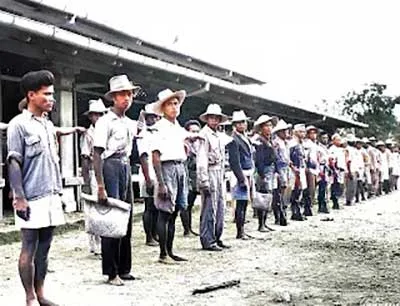The Daring Guerrilla Raid on a Jap Sentry Outpost at Calicanto, Batangas in 1943
On the 8th of December 1941, just hours after the Japanese attack on the American naval base at Pearl Harbor, Hawaii, Japanese aircraft likewise flew into Philippine airspace to neutralize whatever air power the United States had in the country. American warplanes were severely damaged in the initial attacks alone, rendering defenses in the Philippines without air cover1.
The Japanese invasion followed soon thereafter, with American and Filipino troops being generally underequipped and, in many cases, undertrained and therefore able to offer only minimal resistance. On the 24th of December, General Douglas MacArthur issued the order for all defending troops to withdraw to the Bataan Peninsula2.
By the 30th of the same month, Japanese troops, presumably from the strong force that had landed on the shores of Lamon Bay in Tayabas a week earlier, were rolling into Lipa from the town of Rosario. Lipa was then used by the Japanese as the springboard for their occupation of the rest of Batangas3.
The defeat of American and Filipino defenders at Bataan on the 9th of April 1942 did not mean the end of resistance to the Japanese. This resistance had merely gone underground, and guerrilla outfits were soon being clandestinely organized all over the country.
One of these was the Fil-American Irregular Troops (FAIT), organized by a retired United States Army Colonel named Hugh Straughn. This guerrilla outfit would, before long, have many units operating in Luzon, including the province of Batangas.
On the 24th of October 1942, an Inspector General from FAIT Headquarters visited the town of Rosario in Batangas to organize resistance and designate a leader for all FAIT units in the province. This distinction went to an ex-USAFFE4 soldier by the name of Jorge Espina. He was among the defenders during the Japanese landing at Lamon Bay but must have been among those dispersed by the swift Japanese advance and unable to join the withdrawal to Bataan5.
At a time when resistance to Japanese occupation by other guerrilla outfits was still limited to passive activities like the gathering of intelligence and the keeping of peace and order in towns – mostly because of the dearth of arms and ammunition and the threat of reprisals from occupying forces – the FAIT in Batangas under Espina was quickly training recruits and was not reticent about engaging the Japanese in ambushes and actual combat.
In fact, in January of the following year, the Rosario-based FAIT outfit planned and executed an audacious raid on a Japanese sentry outpost near the Calicanto junction in the then-town of Batangas.
Espina himself led the raiding party consisting of sixty men divided into three groups of twenty guerrillas each. One group was personally led by Espina while the other two were led by a Captain Loreto Abaya and a Captain Nicetas Carandang.
The way the raid was executed could have been straight out of a Fernando Poe Jr. movie.
The guerrillas had waited for the cover of dark and then surreptitiously placed themselves close to the sentry outpost. At 11 o’clock, Carandang and one Sergeant Eulalio approached one of the guards, bowed as was required of all Filipinos when approaching Japanese soldiers, and then pretended to ask for a light from the guard.
When Carandang dropped his cigarette, it was the cue for Eulalio to strike the Japanese guard on the head with an iron bar that he had carefully concealed. It was also the cue for the rest of the men to storm the outpost and, armed with one Enfield rifle, pistols and homemade guns called paltik, they shot and killed all seven Japanese soldiers stationed at the outpost at the time.
Unfortunately, also killed was a Filipino member of the Philippine Constabulary who was on duty at the outpost at the time of the raid.
All the arms and ammunition that the Japanese soldiers had in their possession were confiscated by the guerrillas. Given the abject shortage of arms not just among the FAIT but other guerrilla outfits throughout the country, these were vital to the group’s continued harrassment of occupying soldiers in the coming months.
Their raid successful with no loss of lives on their part, the guerrillas withdrew back to the town of Rosario that same night.
Notes and references:
1 “Japanese occupation of the Philippines,” Wikipedia.2 “Philippines campaign (1941–1942),” Wikipedia.
3 “History and Cultural Life of the Barrio of Antipolo” 1953, online at the National Library of the Philippines Digital Collections.
4 The acronym USAFFE stands for United States Armed Forces in the Far East. Read more: “United States Army Forces in the Far East,” Wikipedia.
5 The information about Jorge Espina and details of the Calicanto, Batangas raid are from “A Chronological History of the Luansing Guerrilla Unit,” by Galicano Luansing Jr., 1947, file folder “Luansing Unit, Fil-American Batangas Guerrillas,” File No. 63, downloaded from PVAO.

